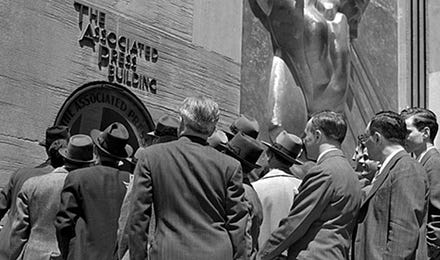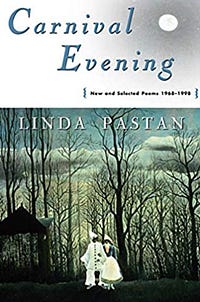|
 |
TWA from Monday, May 22, 2017
“Market Day” by Linda Pastan from Carnival Evening. © Norton, 1998.
ORIGINAL TEXT AND AUDIO - 2017
Today in 1846, the Associated Press was formed in New York City. It was born out of the collective desire of five New York City newspapers to be the first to spread the news of the Mexican-American War northward. Together, they pooled their money to fund a pony express route through Alabama that would beat the U.S. Post Office to the punch.
Since their founding 171 years ago, the AP has broken the news on moments like the assassination of Abraham Lincoln, the bombing of Pearl Harbor, and the death of Pope John Paul. The organization publishes 2,000 stories a day, and 1 million photos per year — all of which are reprinted by its 1,400 member news organizations across the world. The AP currently operates in over 100 countries.
The AP has won a total of 52 Pulitzer Prizes for journalism and photography, many of which were for documentation of the Vietnam War. Most recently, AP received the Pulitzer Prize for public service in 2016 for its investigation of slave labor in the Southeast Asian fishing industry, which clued American consumers into the widely available supermarket brands that were perpetuating slavery. Around 2,000 slaves were freed as a result of the reporting.
It was on this day in 1967 that a show featuring a kindly man in a cardigan and blue sneakers debuted on public television and introduced millions of schoolchildren to the concepts of peace, patience, and diversity. Mister Rogers’ Neighborhood would go on to become the longest-running children’s program on television.
The show was the brainchild of a Protestant minister and puppeteer named Fred Rogers, who believed children needed a show that placed an emphasis on values, tolerance, self-control, and self-esteem. Rogers started as a puppeteer on a show called The Children’s Corner in Pittsburgh, then moved the show to Toronto for a few years, and then back again. Rogers created indelible characters like Henrietta Pussycat, who lived in a small yellow and orange schoolhouse, and X the Owl, who lived in an old oak tree in what became known to millions of children as “The Neighborhood.”
Rogers began each show by entering a door into his fictional home, hanging up his jacket, putting on one of his many cardigans, and trading his dress shoes for blue sneakers. He sang songs, led children on field trips to factories and restaurants, and even did crafts and played music. He spoke directly into the camera and often dealt with serious subjects like war, divorce, death, and competition. Rogers said: “The world is not always a kind place. That’s something all children learn for themselves, whether we want them to or not, but it’s something they really need our help to understand.”
Fred Rogers’s mother knitted all of the cardigans he wore on the show. One of them is hanging, right now, in the Smithsonian Museum. On his continued popularity with children, Fred Rogers said: “One of the greatest gifts you can give anybody is the gift of your honest self. I also believe that kids can spot a phony a mile away.” He died in 2003.
On this day in 1762, Rome’s Trevi Fountain was completed. Today it is perhaps the most famous fountain in the world. It has appeared in many films, most notably in Federico Fellini’s 1960 classic La Dolce Vita.
According to tradition, visitors should toss three coins over their left shoulder into the fountain. The first coin suggests that you will return to the city, the second that you will find a new romance, and the third that you will be married.
Trevi Fountain attracts so many tourists that an estimated 3,000 euros are collected from the fountain at the end of each day. Last year alone, the city collected about $1.5 million from the fountain waters, which it has used to help feed the local poor. Other locals have been attempting to steal from the fountain for many years, using homemade devices like modified fishing poles, but the Italian government has since made it illegal to do so.
The fountain’s massive design — standing 86 feet high and just over 160 feet wide — was 30 years in the making. The design was originally proposed by local poet-architect Nicola Salvi, but Salvi died before the project could be completed and it was taken over by other sculptors.
The site of Trevi Fountain marks the terminal point of an ancient Roman aqueduct, the Acqua Vergine, which still provides drinking water to Rome and supplies the water for the fountain.
Laurence Olivier was born in Dorking, Surrey, on this date in 1907. He was one of the greatest English-speaking actors of the 20th century. He was also a director, and he founded the National Theatre of Britain.
Olivier was the youngest actor ever to be knighted (1947, at age 40), and he was the first actor to be made a peer of the realm; he became Baron Olivier of Brighton in 1970. Lord Olivier died peacefully, in his sleep, in 1989.
Be well, do good work, and keep in touch.®
CARNIVAL EVENING - LINDA PASTAN - CLICK HERE
You’re a free subscriber to The Writer's Almanac with Garrison Keillor. Your financial support is used to maintain these newsletters, websites, and archive. Support can be made through our garrisonkeillor.com store, by check to Prairie Home Productions P.O. Box 2090, Minneapolis, MN 55402, or by clicking the SUBSCRIBE button. This financial support is not tax deductible.


